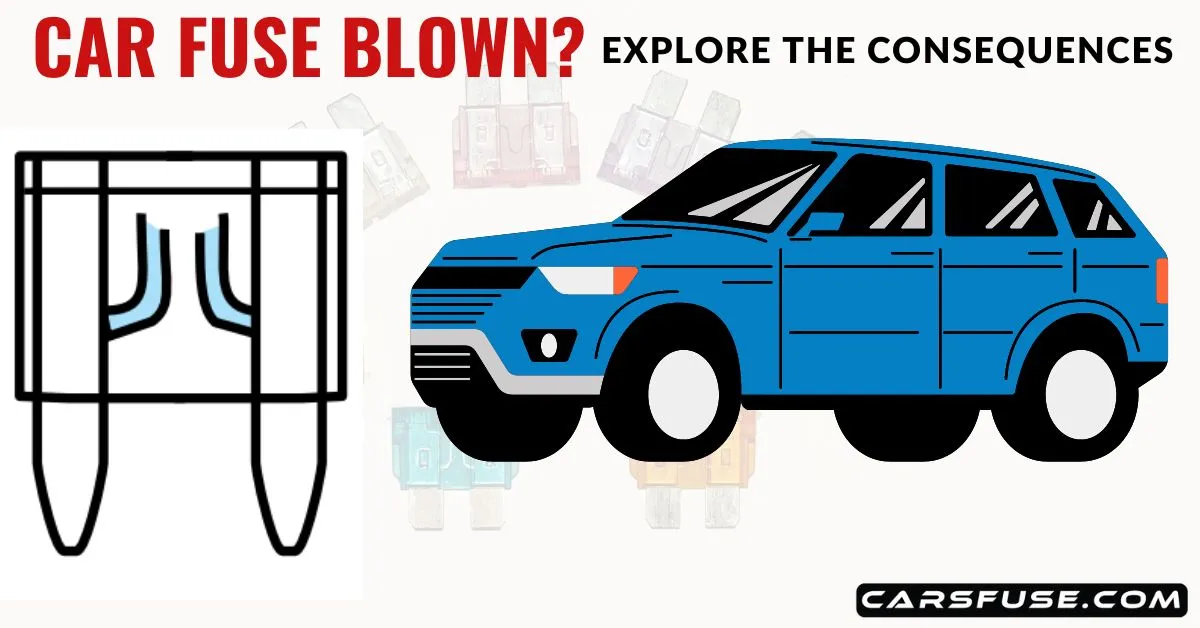Vehicles are complex machines that rely on various components for proper functioning. One of the crucial elements is the electrical system which powers several components.
A vehicle’s electrical system is protected by a small device known as the fuse. There are fuse boxes in a car containing various fuses for specific purposes.
When a car fuse blows, it cuts off the electric circuit and protects electrical components from further damage.
In this article, we will find out what happens when a car fuse blows, and also explore safety tips, and guidelines.
Table of Contents
Basic Understanding of a Car Fuse
As we discussed in the introduction above, a car fuse is a small protective device used to prevent the electrical system from damage due to overload, short circuits, and excessive current flow.
Car fuses are typically small, rectangular-shaped devices made of metal or alloy with a filament or wire inside. The wire is carefully calibrated to melt or blow when the current exceeds a predetermined limit.
This melting or blowing action interrupts the electrical flow, preventing further damage to the circuit and its associated components.
Now, let’s explore the signs of a blown car fuse.
What happens when a Car Fuse blows?
Basically, there are some consequences triggered due to the blowing of a car fuse.

Here are some common signs that indicate a blown car fuse:
Loss of power to specific electrical components
- Non-functioning headlights, taillights, or brake lights.
- Inoperative power windows, door locks, or mirrors.
- Malfunctioning windshield wipers or washers.
- No response from the radio, audio system, or infotainment unit.
- Failure of interior lights, dashboard lights, or instrument cluster.
Non-functioning or malfunctioning electrical systems
- Air conditioning or heating system not working.
- Defective turn signals or hazard lights.
- Disabled power outlets or cigarette lighters.
- Erratic behavior of the power seats or seat heaters.
- Loss of functionality in the horn or alarm system.
Visual indication of a blown fuse
- The metal strip or wire inside the fuse appears melted or broken.
- Burn marks or discoloration on the fuse itself or in the fuse box.
- A blown fuse may also cause the associated fuse box to emit a burning smell.
What could be the reasons for a car fuse to blow?
A car fuse can blow due to different reasons ranging from electrical faults to external factors.
Some common causes of a blown car fuse are listed below.
Overloading the electrical circuit:
- Connecting devices or accessories that draw more current than the fuse rating allows.
- Using high-powered aftermarket electronics without considering the capacity of the electrical system.
- Plugging multiple high-wattage devices into the same power outlet simultaneously.
Short circuits and electrical faults:
- Damaged or exposed wiring that causes a direct connection between the positive and negative sides of the circuit.
- Faulty switches, relays, or connectors create unintended electrical paths.
- Frayed or pinched wires results in contact between wires of different polarities.
Aging or faulty electrical components:
- Worn-out or deteriorated electrical components such as motors, solenoids, or relays that draw excessive current.
- Corrosion or loose connections in the electrical system, lead to increased resistance and subsequent fuse blowing.
- Internal failures within electrical devices or modules, cause abnormal current flow.
Environmental factors and external influences:
- Exposure to moisture or water intrusion compromises the insulation and causes short circuits.
- Vibrations, shocks, or impacts can dislodge or damage the fuses or wiring.
- Extreme temperature fluctuations, especially high heat, can affect the integrity of electrical components.
Conclusion
In conclusion, understanding what happens when a car fuse blows is essential knowledge for every car owner or driver. Fuses play a vital role in protecting various electrical components of a vehicle from excessive currents.
Recognizing the signs of a blown fuse is crucial for troubleshooting electrical issues in a car. Dimmed or non-functioning lights, malfunctioning power windows or door locks, and a non-responsive radio are common indications of a blown fuse.
It is important to note that while a blown fuse may be a straightforward problem, it can also be a symptom of an underlying issue that requires further investigation.
Several factors can cause a car fuse to blow. Overloading the electrical system by using devices with a higher amperage than the fuse can handle is a common cause.
Faulty wiring, damaged components, or water intrusion can also lead to blown fuses. Additionally, replacing a blown fuse with one of higher amperage is not recommended, as it can pose a fire hazard and potentially damage other electrical components.
When a car fuse blows, it is crucial to follow a systematic approach to identify and rectify the issue. This typically involves locating the fuse box, identifying the blown fuse through visual inspection or using a multimeter, and replacing the fuse with one of the same amperage ratings.
If the new fuse blows immediately or shortly after replacement, it is advisable to seek professional assistance to diagnose and repair the underlying problem.
Regular maintenance and inspections of the electrical system, along with adherence to correct fuse amperage ratings, can help prevent blown fuses. Keeping spare fuses in the vehicle is also a wise precaution, as it allows for quick replacement in case of emergencies.
By understanding the basic functioning of a car fuse, being aware of the signs of a blown fuse, and knowing the reasons behind fuse failures, car owners can effectively address electrical issues and ensure the smooth operation of their vehicles.
Tom Smith is a passionate car mechanic and automotive enthusiast, specializing in the intricate world of car fuse boxes. With years of hands-on experience under the hood, he has earned a reputation as a reliable expert in his field. As the founder and content creator of the popular blog website 'carsfuse.com,' Tom has dedicated himself to sharing his extensive knowledge of car fuse boxes and electrical systems with the world.


